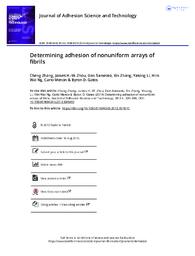Li, Yasong
Person Preferred Name
Yasong Li
Related Works
Content type
Digital Document
Abstract
Dry adhesives containing nonuniform arrays of fibrils were tested for the uniformity of their adhesion strength. These arrays comprised fibrils with nanometer-scale dimensions and lengths tuned from 150 to 1500 nm. The surfaces of the fibrils were rendered hydrophobic through a vapor phase deposition of silane molecules to further tune the adhesion strength of the fibrillar structure. Adhesion force measurements over micrometer-length scales were obtained using a tipless cantilever controlled by a scanning probe microscope. Maps of the adhesion forces depicted diverse variations in adhesion strength with the nonuniform lateral changes in topography. Through an extensive data analysis, differences observed between samples were correlated to changes in processing conditions and surface chemistry modifications. The methods demonstrated in this paper are useful for identifying variations in the adhesion strength of dry adhesives made of nonuniform arrays of fibrils. These advancements are crucial for understanding the correlation between structure and function within nonuniform fibrillar adhesives.
Origin Information
Content type
Digital Document
Abstract
The natural ability of geckos and spiders to climb almost all surfaces using the compliant, nano-structured components on their feet provides motivation for making bio-inspired adhesives. The goal of the studies in this paper is to create an analytical technique for improving the ability to characterize dry adhesives modeled after these biological systems. The technique described herein uses a scanning probe microscope to manipulate a flat test surface in contact with biomimetic fibrillar arrays while monitoring the adhesion forces. Adhesion forces were measured after both normal contact and shear-induced contact between the nano-structured fibrils and the test surface. Results confirm that the adhesion forces are higher for bio-inspired adhesives after a shear-induced contact. Variations in these forces can be measured across the sample with micrometer-scale lateral resolution. This method of analysis can be extended to evaluate bio-inspired dry adhesives with realistic mechanisms of attachment utilized in robotic and similar applications of these materials.
Origin Information
Content type
Digital Document
Abstract
The hierarchical arrays of mesoscale to nanoscale fibrillar structures on a gecko’s foot enable the animal to climb surfaces of varying roughness. Adhesion force between the fibrillar structures and various surfaces is maximized after the gecko drags its foot in one direction, which has also been demonstrated to improve the adhesion forces of artificial fibrillar arrays. Essential conditions that influence the magnitude of these interactions include the lateral distance traveled and velocity between the contacting surfaces, as well as the velocity at which the two surfaces are subsequently separated. These parameters have, however, not been systematically investigated to assess the adhesion properties of artificial adhesives. We introduce a systematic study that investigates these conditions using a scanning probe microscope to measure the adhesion forces of artificial adhesives through a process that mimics the mechanism by which a gecko climbs. The measured adhesion response was different for arrays of shorter and longer fibrils. These results from 9000 independent measurements also provide further insight into the dynamics of the interactions between fibrillar arrays and contacting surfaces. These studies establish scanning probe microscopy techniques as a versatile approach for measuring a variety of adhesion properties of artificial fibrillar adhesives.
Origin Information



